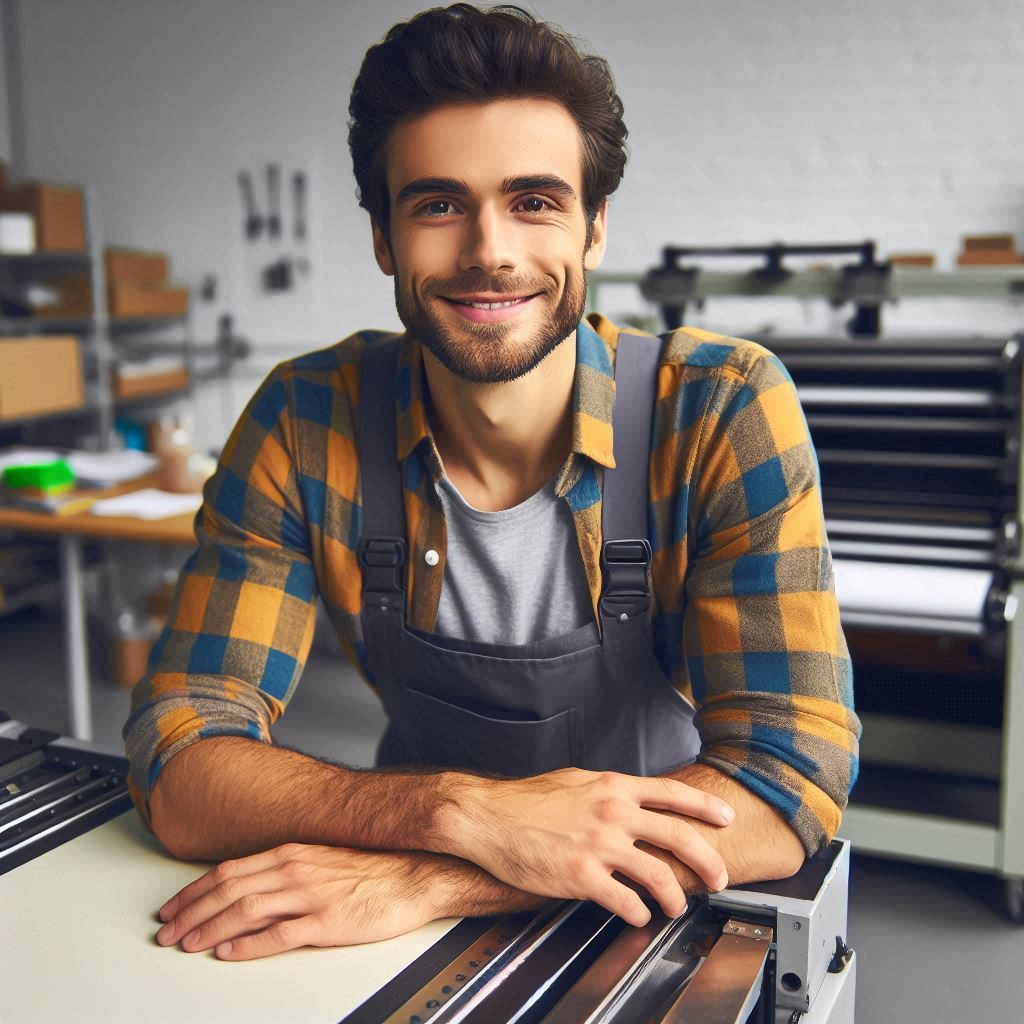Introduction
Printmaking is a dynamic art form that involves creating images through various techniques.
It encompasses a range of methods to produce multiple copies of a single image, each with unique characteristics.
The process involves transferring ink from a matrix to a surface, usually paper, creating a print.
Printmaking holds significant importance in the art world for its versatility and accessibility.
It allows artists to experiment with different methods and materials, producing unique and repeatable artwork.
Printmaking bridges the gap between traditional fine art and mass production, making art more available to a broader audience.
It also offers a platform for artistic expression and innovation, influencing various art movements and styles throughout history.
Several techniques define the printmaking process, each with its distinctive approach.
Woodcut and linocut are common relief techniques, where artists carve into wood or linoleum.
The ink remains in the incised areas and is transferred to paper under pressure.
Engraving, etching, and aquatint are popular intaglio methods, each producing different textures and effects.
Screen printing, or serigraphy, uses a stencil on a mesh screen to apply ink onto a surface.
This method is favored for its vibrant colors and versatility, making it popular for creating posters and textiles.
Lithography involves drawing on a flat stone or metal plate with grease-based materials, then applying ink and pressing it onto paper. It allows for detailed and nuanced images.
These techniques highlight the diversity and creative potential within the printmaking profession.
Each method offers unique possibilities, enabling artists to explore and express their vision in various ways.
History of Printmaking
History of Printmaking and Its Origins
Printmaking dates back to ancient civilizations.
Early methods included stamping and rubbing to create images on surfaces.
The earliest known printmaking originates in China, around the 9th century.
The Chinese used woodblocks to print text and images on paper.
Transform Your Career Today
Unlock a personalized career strategy that drives real results. Get tailored advice and a roadmap designed just for you.
Start NowThis technique spread to Korea and Japan, influencing Asian art.
By the 15th century, printmaking had reached Europe.
Johannes Gutenberg’s invention of the movable type printing press revolutionized the industry.
His press made it possible to produce books quickly and cheaply.
The technology rapidly spread across Europe, facilitating the Renaissance‘s artistic and intellectual explosion.
Printmaking played a critical role in disseminating knowledge and ideas.
Evolution of Printmaking Techniques Over Time
Printmaking techniques evolved significantly over the centuries.
In the 16th century, engraving emerged, offering artists greater control and detail.
This technique used sharp tools to cut into metal plates, creating intricate designs.
In the 18th century, mezzotint introduced a new approach, enabling richer tonal gradations.
This technique involved roughening a copper plate‘s surface to achieve tonal variations.
The 19th century saw the advent of lithography, developed by Alois Senefelder.
Lithography allowed artists to draw directly onto stone or metal plates.
The 20th century introduced new methods like screen printing and digital printmaking.
Screen printing, popularized by artists like Andy Warhol, allowed for vibrant, large-scale prints.
Digital printmaking, with its use of computers and printers, further expanded artistic possibilities.
Each new technique brought innovations that shaped the evolution of printmaking, reflecting changing artistic and technological trends.
Read: Creative Inspirations: Where Do Designers Find Ideas?
Types of Printmaking
Printmaking is a versatile art form with several distinct techniques, each offering unique possibilities.
Understanding these types helps artists choose the right method for their creative vision.
Transform Your Career Today
Unlock a personalized career strategy that drives real results. Get tailored advice and a roadmap designed just for you.
Start NowHere‘s an overview of the main types of printmaking: relief, intaglio, lithography, and screen printing.
Overview of Different Types of Printmaking
- Relief Printmaking: This method involves carving an image into a block, usually wood or linoleum.
The raised areas are inked, and paper is pressed against the block to transfer the image.
Relief printing is known for its bold, graphic qualities and is often used for creating detailed textures. - Intaglio Printmaking: In intaglio, the artist etches or engraves a design into a metal plate.
Ink is applied and then wiped from the surface, leaving ink only in the incised lines.
The plate is then pressed onto paper, transferring the ink from the grooves.
This technique is favored for its ability to create fine lines and rich tonal variations. - Lithography: Lithography relies on the repulsion between oil and water.
An image is drawn with greasy crayons or ink on a flat stone or metal plate.
The surface is then treated so that ink adheres only to the drawn areas.
When pressed onto paper, the image transfers with a smooth, painterly quality. - Screen Printing: Also known as serigraphy, this technique involves using a stencil on a mesh screen.
Ink is pushed through the screen onto the paper or fabric beneath.
Screen printing allows for vibrant colors and is widely used for posters, textiles, and other mass-produced items.
Each Type and Their Unique Characteristics
- Relief Printmaking: Provides bold, high-contrast prints and is relatively simple to master.
Its graphic nature suits posters and decorative prints. - Intaglio Printmaking: Offers depth and detail, making it ideal for fine art prints that require intricate lines and textures.
- Lithography: Achieves smooth gradations and subtle shading, ideal for artworks requiring a painterly approach.
- Screen Printing: Allows for vibrant colors and is excellent for creating multiples, making it popular in commercial and artistic contexts.
Each printmaking type presents unique tools, processes, and outcomes, giving artists a broad spectrum of options to explore and master.
Read: Building an Online Presence for Ceramic Artists
Tools and Materials in Printmaking
Printmaking is a fascinating art form that involves various tools and materials.
Understanding these elements is essential for creating quality prints.
Introduction to the Tools and Materials Used in Printmaking
Printmaking requires a range of specialized tools and materials.
These include printing presses, brayers, and various types of inks and papers.
Artists use these tools to transfer ink onto paper or other surfaces to create their artwork.
Each tool and material has a unique function that contributes to the final print’s quality and appearance.
For instance, a printing press applies even pressure to the inked plate, ensuring a clean and precise print.
Different Types of Paper, Inks, and Printing Presses
Paper
The choice of paper is crucial in printmaking.
Artists often use papers like acid-free, rag, or specialty printmaking papers.
These papers are chosen based on their texture, weight, and absorbency, which affect how ink is absorbed and how the print’s details appear.
Inks
Inks come in various types, including oil-based, water-based, and acrylic.
Oil-based inks are durable and produce rich colors but require solvents for cleanup.
Water-based inks are easier to clean but might not be as vibrant.
Acrylic inks are versatile and fast-drying.
Each type of ink interacts differently with paper and can create varied effects.
Printing Presses
There are several types of printing presses, including etching presses, lithography presses, and relief presses.
Etching presses are used for intaglio techniques and provide a high degree of control over pressure.
Transform Your Career Today
Unlock a personalized career strategy that drives real results. Get tailored advice and a roadmap designed just for you.
Start NowLithography presses are designed for flat printing surfaces, while relief presses are used for woodcuts and linocuts.
Each press type is suited to different printmaking methods and impacts the print’s texture and detail.
They each play a crucial role in achieving the desired artistic effect.
Read: Essential Anatomy Tips for Character Designers

Techniques and Processes in Printmaking
Printmaking is an intricate art form with various techniques, each offering unique results.
Understanding the processes involved is crucial for creating successful prints.
Step-by-Step Explanation of the Printmaking Process for Each Type
- Relief Printing: Start by carving an image into a block, typically wood or linoleum.
Apply ink to the block‘s surface.
Press paper onto the inked block.
Carefully peel off the paper to reveal the print. - Intaglio Printing: Begin by engraving or etching an image onto a metal plate.
Apply ink to the plate, ensuring it fills the etched lines.
Wipe excess ink off the surface, leaving ink only in the grooves.
Press the plate onto damp paper through a press to transfer the image. - Lithography: Draw an image onto a lithographic stone or metal plate using a greasy medium.
Apply a chemical solution to the surface.
This solution ensures that only the greasy areas attract ink.
Roll ink onto the plate and press it onto paper. - Screen Printing: Create a stencil on a screen mesh. Place the screen on the paper or fabric.
Apply ink over the screen, using a squeegee to push it through the stencil.
Lift the screen to reveal the print. - Monotype: Paint or draw on a smooth plate with ink or paint.
Press paper onto the plate to transfer the image.
Each print is unique due to the nature of the process.
Importance of Planning and Preparation in Creating a Successful Print
Proper planning and preparation are essential in printmaking.
First, sketch your design thoroughly to visualize the final print.
Select the appropriate materials and tools for your chosen technique.
Accurate registration and careful handling of materials prevent errors and ensure high-quality prints.
Thorough preparation can make the difference between a successful print and a disappointing outcome.
By mastering these techniques and focusing on meticulous preparation, printmakers can create stunning and impactful artworks.
Read: Ceramic Art in Modern Interior Design
Famous Printmakers
Printmaking has a rich history shaped by numerous influential artists.
This section highlights some renowned printmakers and their contributions to the field.
Some Well-Known Printmakers Throughout History
One of the earliest famous printmakers is Albrecht D‘rer, a German Renaissance artist.
D‘rer is known for his detailed woodcuts and engravings.
His works, such as “The Apocalypse,” demonstrated intricate craftsmanship and innovation in printmaking techniques.
Another pivotal figure is Rembrandt van Rijn, a Dutch master renowned for his etchings.
Rembrandt’s printmaking skill captured dramatic light and shadow, enhancing the emotional depth of his portraits.
Transform Your Career Today
Unlock a personalized career strategy that drives real results. Get tailored advice and a roadmap designed just for you.
Start NowHis techniques influenced generations of artists in the art of etching.
Moving to modern times, Japanese artist Katsushika Hokusai revolutionized printmaking with his ukiyo-e woodblock prints.
His series “Thirty-Six Views of Mount Fuji” exemplifies the fusion of art and nature, impacting Western artists profoundly.
Their Contributions to the Art of Printmaking
Albrecht D‘rer contributed to the evolution of woodcut and engraving techniques.
His meticulous attention to detail and innovative use of perspective set new standards in printmaking.
D‘rer’s prints were widely distributed, spreading his influence across Europe.
Rembrandt‘s contributions lie in his masterful etching techniques.
His ability to manipulate light and texture in prints added depth and realism.
Rembrandt‘s etchings provided valuable insights into the human condition, elevating printmaking to a new artistic level.
Hokusai’s impact was significant in popularizing woodblock printing outside Japan.
His use of vibrant colors and dynamic compositions in prints introduced new visual concepts to the global art scene.
Hokusai‘s prints helped shape the direction of modern art, blending Eastern and Western styles.
These printmakers not only advanced technical aspects but also expanded the thematic and emotional range of printmaking.
Their legacies continue to inspire and influence contemporary artists and printmakers.
Uncover the Details: The Benefits of Learning Code for Web Designers
Find Out More: Effective Time Management for Advertising Designers
Uncover the Details: How to Get an Internship in Museum Curation
Contemporary Printmaking
Overview of how printmaking has evolved in the modern era
Printmaking has undergone remarkable transformations in the modern era.
Traditionally, printmaking involved techniques like etching, woodcut, and lithography.
These methods have evolved significantly, embracing new technologies and styles.
Transform Your Career Today
Unlock a personalized career strategy that drives real results. Get tailored advice and a roadmap designed just for you.
Start NowArtists now blend traditional techniques with modern innovations, creating dynamic and diverse prints.
In the early 20th century, movements like Expressionism and Abstract Art expanded printmaking‘s boundaries.
Today, contemporary printmaking reflects a fusion of past and present, incorporating both manual and digital processes.
Artists experiment with materials, scales, and methods, challenging conventional definitions of printmaking.
Exploration of digital printmaking techniques and their impact on the profession
Digital printmaking represents a major shift in the field.
This technique leverages computer technology to create prints.
Digital tools offer precision and flexibility, enabling artists to produce complex and detailed works.
Digital printmaking has democratized the art form.
It allows for easy reproduction and distribution of prints, reaching a broader audience.
Artists can now create and share their work without the need for traditional press equipment.
This accessibility has broadened the scope of printmaking, attracting new talents and perspectives.
However, digital printmaking also raises questions about authenticity and originality.
Traditionalists debate the value of digital prints compared to hand-made ones.
Despite this, digital techniques have undeniably expanded the creative possibilities for printmakers.
They provide new ways to experiment and engage with the medium.
Overall, contemporary printmaking blends historical techniques with modern innovations.
The evolution of digital printmaking has transformed the profession, offering fresh opportunities and challenges.
This ongoing evolution continues to shape the future of printmaking, blending tradition with technology.
Career Opportunities in Printmaking
Printmaking offers diverse career paths for passionate artists and professionals.
This section explores various opportunities in the field.
Transform Your Career Today
Unlock a personalized career strategy that drives real results. Get tailored advice and a roadmap designed just for you.
Start NowPotential Career Paths for Printmakers
Printmakers can pursue multiple career paths.
They may work as studio artists, creating original prints for exhibitions or private collections.
Many printmakers become art instructors, teaching techniques and theory in schools and universities.
They might also find roles in publishing, where they create illustrations or designs for books and magazines.
Printmakers can also work in commercial settings.
For instance, they may become designers for textile companies or work in advertising agencies.
Some specialize in producing limited edition prints for art collectors.
Others might focus on conservation and restoration, preserving and maintaining historic prints.
Additionally, printmakers often engage in collaborative projects with other artists.
These collaborations can lead to innovative work and expanded professional networks.
They might also participate in artist residencies, which provide opportunities for creative development and exposure.
Information on Job Opportunities in Galleries, Museums, and Educational Institutions
Galleries offer various roles for printmakers.
They may work as curators, organizing exhibitions and managing collections.
Galleries often hire printmakers to handle installations or create special projects.
They also serve as consultants, advising on the acquisition and presentation of print artworks.
Museums present additional career options.
Printmakers can work as museum educators, developing programs and materials to engage visitors.
They might also work in conservation, preserving and restoring print collections.
Museums often employ printmakers for research roles, studying and documenting historical print techniques and artists.
Educational institutions provide numerous opportunities.
Transform Your Career Today
Unlock a personalized career strategy that drives real results. Get tailored advice and a roadmap designed just for you.
Start NowPrintmakers can teach at high schools, colleges, or universities, sharing their expertise with students.
They may also develop and lead workshops, offering hands-on experiences in printmaking techniques.
Educational roles often include mentoring emerging artists and fostering creativity in academic settings.
In summary, printmaking offers a wide range of career opportunities.
From creating art to working in galleries, museums, and educational institutions, the field provides diverse paths for professional growth and development.
See Related Content: What Does a Packaging Designer Do? Career Overview
Conclusion
Printmaking is a versatile and impactful art form that has been used for centuries to convey powerful messages and evoke emotions.
From traditional techniques like woodcut and etching to modern digital methods, printmaking offers a unique way for artists to express themselves and reach a wide audience.
If you have a passion for art and enjoy working with different materials and techniques, printmaking could be a rewarding career choice for you.
Take some classes, experiment with different styles, and collaborate with other artists to explore the endless possibilities of printmaking.
Whether you’re interested in creating fine art prints or designing commercial materials, there are countless opportunities for printmakers to showcase their skills and make a lasting impact in the art world.
So don’t be afraid to dive into the printmaking profession and see where your creativity takes you!
[E-Books for Sale]
The Big Book of 500 High-Paying Jobs in America: Unlock Your Earning Potential
$19.99 • 500 High-Paying Jobs • 330 pages
Explore 500 high-paying jobs in America and learn how to boost your career, earn more, and achieve success!
See All 500 High-Paying Jobs of this E-Book
1001 Professions Without a Degree: High-Paying American Jobs You Can Start Now
$19.99 • 1001 Professions Without a Degree • 174 pages
Discover 1001 high-paying jobs without a degree! Unlock career tips, skills, and success strategies for just $19.99!



